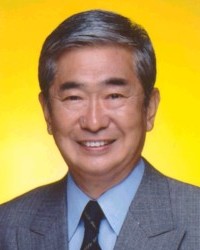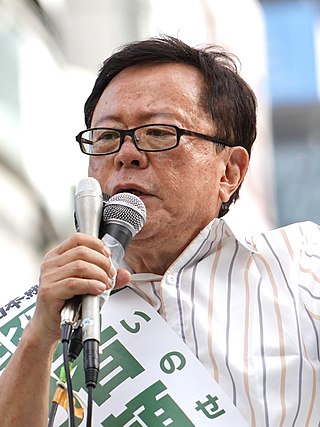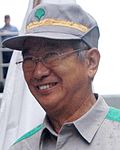
Shintaro Ishihara was a Japanese politician and writer, who served as the Governor of Tokyo from 1999 to 2012. Being the former leader of the radical right Sunrise Party, later merged with Toru Hashimoto's Japan Restoration Party out of which he split his faction into the Party for Japanese Kokoro, he was one of the most prominent ultranationalists in modern Japanese politics. Ishihara was infamous for his misogynistic comments, his xenophobic views and his racist remarks against Chinese and Koreans in Japan, including his use of the antiquated pejorative term "sangokujin". He was also a denier of the Nanjing Massacre.

Naoto Kan is a Japanese former politician who served as Prime Minister of Japan and President of the Democratic Party of Japan (DPJ) from June 2010 to September 2011.

Yuriko Koike is a Japanese politician, who has served as the Governor of Tokyo since 2016. Previously, she was also served as a member of the House of Councillors from 1992 to 1993, a member of the House of Representatives from 1993 to 2016, Minister of the Environment under from 2003 to 2006, and Minister of Defense in between July and August 2007.

The 2007 Tokyo Gubernatorial elections were held on April 8, 2007 as part of the 16th unified local elections. There were fourteen candidates, among them the incumbent governor Shintaro Ishihara. Most candidates, with the exception of Kurokawa and Yamaguchi, ran as independents, but some were supported by various parties.

The Hamaoka Nuclear Power Plant is a nuclear power plant in the city of Omaezaki in Shizuoka Prefecture, on Japan's east coast, 200 km south-west of Tokyo. It is managed by the Chubu Electric Power Company. There are five units contained at a single site with a net area of 1.6 km2. The two oldest units were permanently shut down in 2009 and are currently being decommissioned. Three units Hamaoka-3, 4 and 5 are in long-term shutdown since the aftermath of the Fukushima accident in 2011. From 2011 to 2017 these units underwent significant safety upgrades to enhance their resistance against extreme environmental impacts such as earthquakes and tsunamis. In 2014, Chubu Electric submitted an application to resume power generation, but the review by the Nuclear Regulation Authority has been progressing slowly, and is still ongoing as of 2024. A sixth unit was proposed in 2008 but its construction has been deferred indefinitely.

Yōichi Masuzoe is a Japanese politician who was elected to the position of governor of Tokyo in 2014 and resigned in June 2016 due to the misuse of public funds. He was previously a member of the Japanese House of Councillors and the Japanese Minister of Health, Labor, and Welfare. Before entering politics, he became well known in Japan as a television commentator on political issues.

Yukio Aoshima was a Japanese politician who served as Governor of Tokyo from 1995 to 1999. He is also well known as a TV actor, novelist, film director, screenwriter and songwriter.
Events in the year 2007 in Japan.

The 2008 Liberal Democratic Party presidential election was held on 22 September 2008 after the incumbent party leader and Prime Minister of Japan Yasuo Fukuda announced that he would resign on 1 September 2008, only 11 months after taking office on 25 September 2007 following a leadership election on 23 September 2007. Tarō Asō, who had lost to Shinzo Abe in the 2006 leadership election and then again lost to Fukuda in 2007, was widely seen as the frontrunner to replace him, and announced on 2 September 2008 he was ready to take over as party leader. Aso won the leadership election against four opponents, receiving 67% of the vote.

General elections were held in Japan on 16 December 2012. Voters gave the Liberal Democratic Party a landslide victory, ejecting the Democratic Party from power after three years. It was the fourth worst defeat suffered by a ruling party in Japanese history.

Prefectural elections for the Tokyo Metropolitan Assembly were held on 12 July 2009. In the runup to the Japanese general election due by October they were seen as an important test for Taro Aso's ruling coalition of the Liberal Democratic Party (LDP) and the New Komeito. New Komeito considers Tokyo as an important stronghold and had repeatedly asked Prime Minister Aso to avoid holding the two elections within a month of each other.
This article lists events in 2011 in Japan.
The 17th unified local elections in Japan took place in April 2011. In the first phase on April 10, 2011, 12 governors, 41 prefectural assemblies as well as five mayors and 15 assemblies in cities designated by government ordinance were elected. In the second phase on April 24, 2011, mayors and assemblies in hundreds of cities, "special wards" of Tokyo, towns, and villages were up for election. Additionally, a by-election for the National Diet was held in Aichi on April 24.
The 16th unified local elections in Japan took place in April 2007. In the first phase on April 8, 2007 13 governors, 44 prefectural assemblies as well as four mayors and 15 assemblies in cities designated by government ordinance were elected. In the second phase on April 22, 2007 mayors and/or assemblies in hundreds of cities, special wards, towns and villages were up for election. Additionally, by-elections for the national Diet were held in Fukushima and Okinawa on April 22.
Events in the year 2012 in Japan.

The 2012 Tokyo gubernatorial election took place on December 16, 2012, which was held on the same day as the general election.

Kenji Utsunomiya is a Japanese lawyer and former chair of the Japan Federation of Bar Associations.

The 2014 Tokyo gubernatorial election took place on February 9, 2014 to replace outgoing Governor Naoki Inose, who resigned effective December 24, 2013. Yōichi Masuzoe was declared the winner in exit polling, with a substantial lead over the fifteen other candidates. His final tally was 2,112,979 votes (42.86%), with his two closest competitors Morihiro Hosokawa and Kenji Utsunomiya failing to break the 20% mark. Total turnout was 4,930,251 (46.14%), significantly lower than the 62.6% turnout in the 2012 election.

The Party for Japanese Kokoro, officially the Party to Cherish the Heart of Japan, was a Japanese political party. It was formed as the Party for Future Generations on 1 August 2014 by a group of Diet members led by Shintarō Ishihara. The party adopted its final name in December 2015, and ended up dissolving in November 2018.

The Third Abe cabinet governed Japan under the leadership of the prime minister, Shinzō Abe, from December 2014 to November 2017. The government was a coalition between the Liberal Democratic Party and the Komeito and controlled both the upper and lower houses of the National Diet.
















